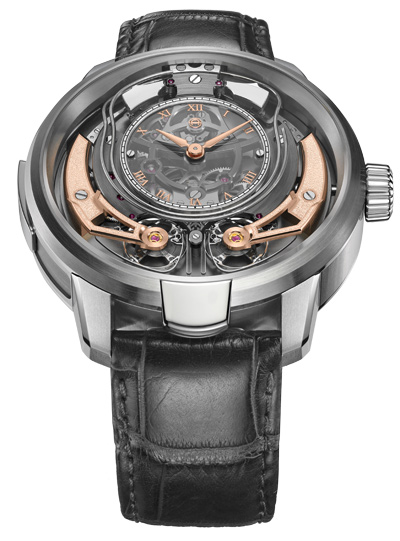There are 26 cantons in Switzerland, and most of them are officially either German- or French-speaking — with a scattering of Italian, concentrated in Ticino. Only three cantons are fully bilingual. That is, their administration and population operate equally in German and in French. (One canton is trilingual; Graubünden uses German, Italian and Romansch, but never mind that right now.) One of those three bilingual cantons is Bern, the administrative heart of Switzerland. The Bernese city of Biel/Bienne reflects this linguistic dualism in its official name. It also happens to be the city in which watchmaking brand Armin Strom is headquartered.
Compared to the other watch companies associated with Biel/Bienne, Armin Strom is relatively small, independent, and has no corporate structures or affiliates located on the other side of the Röstigraben (the metaphorical wall that demarcates the linguistic divisions of Switzerland). While most watchmaking companies will identify themselves along national lines — one is a Swiss brand, or a German brand, or a Japanese brand, for example — few go into such granular detail as Armin Strom, which proudly declares itself a Swiss-German brand.
The company history dates from 1967, when the watchmaker Armin Strom founded his eponymous enterprise in the Bernese city of Burgdorf. He specialised in hand-skeletonising watch movements, eventually becoming known for this specific skill. His successors, Serge Michel and Claude Greisler, took over the registered company of Armin Strom AG (created in 2006), handling the commercial and product development sides of Armin Strom respectively. Claude Greisler received his watchmaking education in Solothurn, ensuring the continuity of Armin Strom timepieces in the Swiss-German horological tradition.
Recently, we had the opportunity to speak with Claude Greisler, and to find out more about Swiss-German watchmaking, and how it is expressed in the watches of Armin Strom.

WorldTempus: You frequently describe Armin Strom not just as a Swiss watch brand, but specifically as a Swiss-German watch brand. Can you tell us a bit more about what that means?
Claude Greisler: The watches that we make are influenced by our culture, that’s something we can all agree. The Swiss-French, or Romandy, style of watchmaking is more French influenced, while we have a more Germanic approach. But I don’t say that our watches are German; they are Swiss-German, because Swiss-German culture is still distinct from German culture. Perhaps one reason why I emphasise the Swiss-German designation is that we are based in Biel/Bienne. In most other Swiss cantons, it’s very strongly French or very strongly German. But over here we are always very conscious of that dual-language environment, and it’s natural for us to make the distinction.
WT: Over the years, as a watch journalist who comes across hundreds of watch movements, modern and historical, you start to get a sense of watchmaking styles. It’s not 100 percent accurate, of course, but I can generally pick out some aspects of a watch movement that tell me it’s typical of the Vallée de Joux style of high complication, or if it’s perhaps a more industrial, production-oriented approach that would suggest a Le Locle/La Chaux-de-Fonds origin. Traditional German style is easily identified, and so is traditional English style. I compare it to how a classical music lover can differentiate a piece of music written in the Baroque or Romantic era.
CG: There are definitely origins that can be identified, especially if you know well the various movement families. The story of the Swiss watchmaking industry can be very different, depending on which city you look at; if they had a more industrial or artisanal approach to watchmaking. And if you focus on the Swiss-German approach, which is very heavy on engineering, on order, you will see something different again. It’s very clear in some of the independents like Beat Haldimann or Andreas Strehler, or if you look at the work of Felix Baumgartner. We went to watchmaking school together, in Solothurn. You can say that Swiss-German watchmaking has a style that you would call minimalist, perhaps, or Bauhaus. Another term that is useful to describe this style is “results-based”. It’s a bit of a stereotype, but Swiss-Germans are more shy, or maybe a better word is “reserved” — which some people may take for arrogance. But in terms of design, this leads to aesthetic purity.

WT: If we take the example of the Armin Strom Minute Repeater Resonance, however, I wouldn’t necessarily call it minimalist! There is a clear emphasis on the aesthetic aspect of this watch — the symmetry, the finishes, the curve of the gongs.
CG: You can see it on a deeper level. We take a “form follows function” perspective, which is not to say that form is less important! Because of our resonance technology, with two spirals connected by the clutch spring, we also wanted to emphasise the resonating component of the minute repeater mechanism — the gongs. So we put them on the dial, and then the placement of the other components had to be a certain way, and so on. It was the function, resonance, that determined the concept, and therefore also determined the design. Minimalist does not mean boring. Do you know Dieter Rams and his 10 principles of good design? Pure design follows the utilitarian path, and in the Armin Strom Minute Repeater Resonance, we used design to highlight the resonating components of this watch. Really, less is more — there is more clarity!




